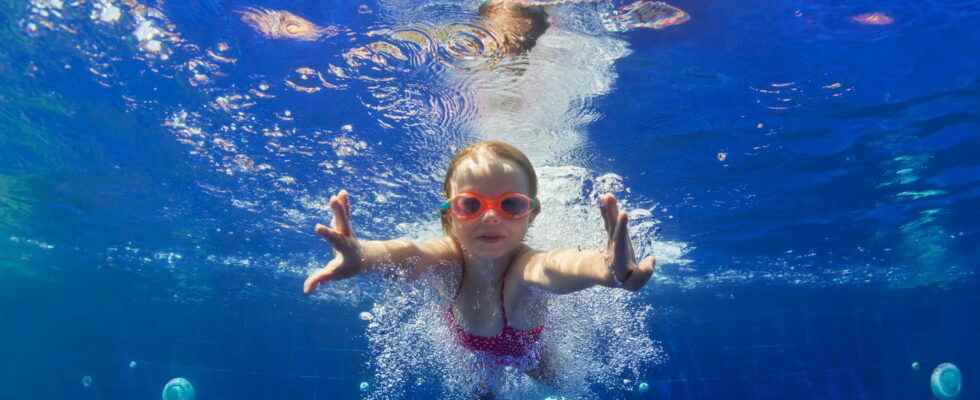Every summer, accidental drownings cause approximately 50 deaths among children. A lack of supervision is noted in 1 out of 2 drownings. The place most at risk: swimming pools. How to avoid drowning and what to do in the event of an accident with Dr Estelle Darviot, head of pediatric medical and surgical emergencies at the CHU d’Angers.
[Mise à jour le 21 juin 2022 à 11h23] According to the DROWNINGS 2021 survey published by Public health France in June 2022, 22% of accidental drownings recorded during the summer of 2021 affected children under the age of 6. Every summer, accidental drownings cause about 50 deaths in children under 13, recalls Public Health France. A lack of supervision is noted in 1 out of 2 drownings. What are the symptoms in case of drowning? If the child drink the cup ? How the save ? How avoid drowninge ?
According to the DROWNINGS 2021 survey published by Public health France in June 2022, 22% of accidental drownings recorded during the summer of 2021 affected children under the age of 6. They are, along with the over 65s, the most affected by these accidents. 6% of children died after drowning. Every summer, accidental drownings cause about 50 deaths in children under 13 years old. A lack of supervision is noted in 1 out of 2 drownings.Concerning the places where drownings occur, children drown the most in swimming pools (compared to the sea or the river).
Contrary to what one can see in certain films, a drowning child does not make a sound : he falls to the bottom of the water and has no time to struggle or call for help. “The main warning sign of a drowning is a child who cannot come to the surface of the water, who has difficulty breathing or who stops breathing when he comes to the surface”, says Dr Estelle Darviot.
Drinking the cup means swallowing water involuntarily during a swim. “In this case, we all have the cough reflex to keep water out of the lungs, like when you swallow food the wrong way. It’s an adapted reflex and if we drink water that goes into the digestive tract, it doesn’t matter since it won’t prevent us from breathing.“, explains the pediatric emergency doctor. Conversely, drowning means asphyxiation by flooding of the respiratory tract.
► If your child is not as usual after several minutes, and in particular if he has one or more of these signs, you must quickly notify the emergency services.
If your child is unconscious but breathing:
- Call 15 or 112.
- Put it aside.
- Straighten his head.
- warm it up
If your child is unconscious and not breathing:
- Call for help around you (neighbor, nurse, a particular first aider, doctor, etc.).
- Call 15 or 112.
- Lay the child on the floor (no mattress or cushions) and practice cardiac massage and mouth to mouth. “Mouth to mouth alone is not enough, the child who is not breathing will most often also be in cardiac arrest (or will be soon) and it is more important to do cardiac massage “, comments Dr. Estelle Darviot.
“The care will be the same, whatever the age of the child, she continues. The first thing to do is to take it out of the water and check its condition. If he is breathing more or less correctly, we will install him comfortably, possibly on his side, and we will warm him up. If he is no longer breathing, you must notify the emergency services and begin resuscitation maneuvers, namely mouth-to-mouth and cardiac massage. “.
It is necessary to ensure that the bathing place is well protected, so that the child cannot access it alone and that there is always have a responsible adult nearby. “We can of course put armbands on the child but also teach him that this is a potentially dangerous place where you should never go alone and you have to be carefuladvocates Dr. Estelle Darviot. For example, we can explain to him that if the ball falls into the water, he must call an adult to go get it. You have to teach children reflexes, this is part of safety education. Because, even if there are barriers, there will always be a moment when someone can forget to close it. It is never 100% reliable protection. In general, no security measure is infallible so you have to be vigilant because it doesn’t take long to drown and everything can be done in silence“.
- Teach children to swim as soon as possible and familiarize them with aquatic ease from an early age
- Supervise children at all times, always stay close to them when they are playing at the water’s edge and bathe with them when they are in the water
- Each child must be constantly and closely supervised by a single adult who takes responsibility for them during swimming time.
- Take special care when swimming in “above-ground” pools (not buried) which do not have a safety device
Thanks to Dr Estelle Darviot, head of pediatric medical and surgical emergencies at the CHU d’Angers.
